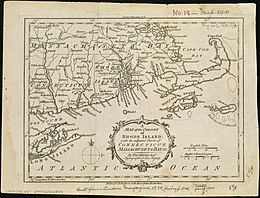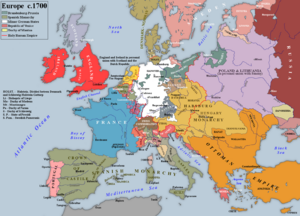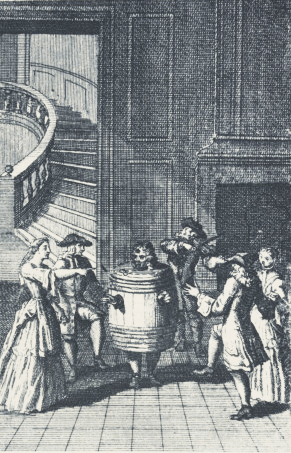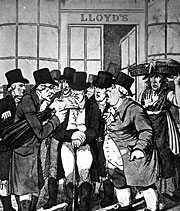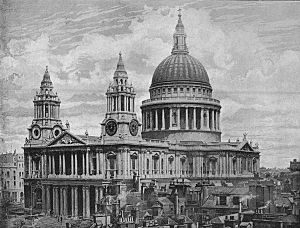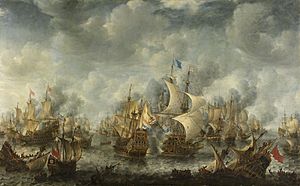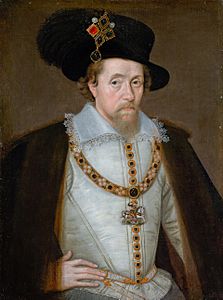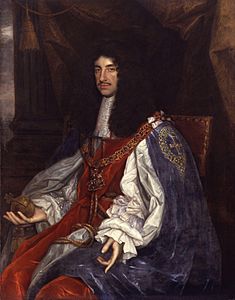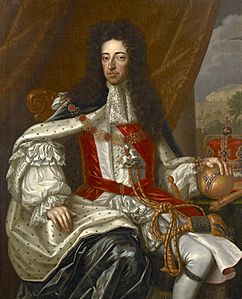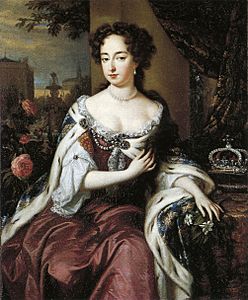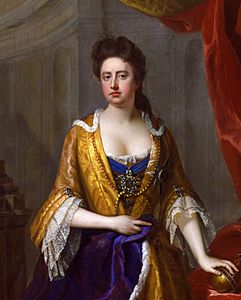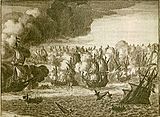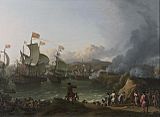Stuart period facts for kids
| 1603–1714 | |
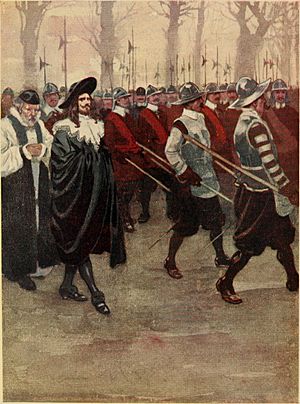
King Charles I and the soldiers of the English Civil War as illustrated in An Island Story: A Child's History of England (1906)
|
|
| Preceded by | Elizabethan era |
|---|---|
| Including | |
| Followed by | Georgian era |
| Monarch | |
| Leader(s) | |
The Stuart period in British history lasted from 1603 to 1714. This was when the House of Stuart royal family ruled. The period ended when Queen Anne died. Then, King George I from the German House of Hanover became king.
This time was full of arguments and religious problems. There was even a big civil war. This war led to King Charles I being executed in 1649. For a while, the Stuarts were not in power. This time is called the Interregnum. It was mostly controlled by Oliver Cromwell. After Cromwell's government failed, Charles II was welcomed back to the throne in 1660. His brother, James II, was removed from power in 1689 during the Glorious Revolution. His Protestant daughter Mary II and her Dutch husband William III took over. Mary's sister Anne was the last Stuart ruler.
Contents
- Political History of the Stuart Era
- Social and Economic Life in Stuart Britain
- Foreign Policy of the Stuart Kings
- Timeline of the Stuart Period
- Stuart Monarchs
- Historical Gallery
Political History of the Stuart Era
King James I: 1603–1625
Who Ruled England?
In England, the king and the highest nobles ruled the country. Local areas were run by lesser nobles and wealthy landowners called the gentry. These groups made up about 2% of families. They owned most of the good farmland. They also controlled local government.
The number of nobles grew a lot between 1540 and 1640. Their wealth and power also increased. In 1611, King James I created a new title, "baronet." This was a way to raise money for the crown. Many gentry families became much wealthier. This happened when they bought land taken from monasteries by Henry VIII of England in the 1530s.
The Three Kingdoms of James I
When Elizabeth I of England died, James VI of Scotland also became king of England. England and Scotland were separate countries but shared the same king. He also became king of Ireland. England had just finished taking back control of Ireland after a long war.
James's officials in Ireland brought central government control to the whole island. Most Irish people were Catholic. But James encouraged Protestants from Scotland to settle in the Ulster region of Ireland. These settlers were called Scots-Irish. Many of them later moved to the new American colonies.
King Charles I: 1625–1649
As King James I grew older and weaker, his son Charles and his friend George Villiers took more control. By 1624, Buckingham was almost running England. In 1625, Charles became king. England was fighting in a European war and had growing religious problems.
Buckingham and Charles decided to ally with France against Spain. But their military adventures were big failures. People blamed Buckingham for England's problems, not the king. When Parliament tried to remove Buckingham, the king simply stopped Parliament from meeting. Buckingham was killed in 1628 by a soldier.
Like his father, King Charles believed he had a God-given right to rule. He found it hard to work with Parliament. In 1629, the king closed Parliament. He then ruled alone for eleven years.
Charles I's Personal Rule: 1629–1640
The English government was quite small. The king had no permanent army and few officials across the country. Local leaders usually enforced laws. Charles's biggest challenge without Parliament was finding money. The crown was deeply in debt.
Charles saved money by making peace with France in 1629 and Spain in 1630. This kept England out of the Thirty Years' War. He also found clever ways to raise money without Parliament's approval. He sold special rights to businesses. He fined landowners for using royal forests. He also brought back an old rule. Wealthy men who had not become knights had to pay a fine. Oliver Cromwell was one of many who had to pay this fine.
The king also started collecting "ship money." This was meant for naval defense. But he collected it from towns far from the coast. This made many people, especially wealthy townspeople, very angry. These new taxes caused a lot of anger. But they did help the king balance his budget for a while.
The Long Parliament of 1640
Problems started in Scotland. The king tried to force a new prayer book on them. This threatened their religion. The Scots fought back and drove out English forces. They even occupied part of northern England. A big revolt also broke out among Catholics in Ireland. Thousands of Scots-Irish were killed. New taxes were needed to pay for military action.
So, King Charles had to call a new Parliament. This was the Long Parliament, which met in November 1640. It quickly began to accuse the king's main advisors of treason. To stop the king from closing it whenever he wanted, Parliament passed the Triennial Act. This law said Parliament had to meet at least once every three years. Charles reluctantly agreed to this in February 1641.
Civil War and Interregnum: 1642–1660
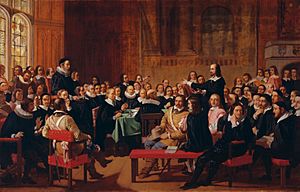
The First English Civil War (1642–1645) ended with Parliament's supporters winning. They were called "Roundheads" because of their short hair. The Royalists, who supported the king, were called "Cavaliers". The Second English Civil War (1648–1649) also ended with Charles losing. He was executed in January 1649.
For a time, England did not have a king. It became a republic called the Commonwealth of England (1649–1660). Oliver Cromwell ruled directly from 1653 until he died in 1658. After he died, his government fell apart. The Convention Parliament then invited Charles II, King Charles I's son, to return from exile and become king.
The Civil War (1642–1651) involved many battles between Parliament's supporters and the Royalists. The first two wars were between King Charles I and Parliament. The third war was between King Charles II and Parliament. The war ended when Parliament won the Battle of Worcester in 1651.
The war had three main outcomes: King Charles I was tried and executed in 1649. His son, Charles II, went into exile in 1651. The English monarchy was replaced first by the Commonwealth of England (1649–1653) and then by the Protectorate under Oliver Cromwell (1653–1658). After Cromwell died, his son Richard Cromwell could not rule effectively. The army then ruled the country.
The war also showed that an English king could not rule alone. Parliament was also essential.
Oliver Cromwell's Rule
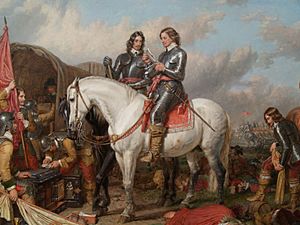
From 1649 to 1659, Oliver Cromwell was the most powerful person in England. He was a very successful general for Parliament. He worked hard to make sure people saw his rule and his wars as successful. Cromwell is still a very talked-about person in British history.
The Commonwealth: 1649–1653
After the king was executed, England became a republic called the Commonwealth. A Council of State was set up to manage things, and Cromwell was part of it. But his real power came from the army. Cromwell tried to get Parliament to set dates for new elections and to create a tolerant national church.
However, Parliament was slow to act. Frustrated, Cromwell eventually dismissed Parliament in 1653. He then called a new Parliament where all members were chosen by him. This was sometimes called the Barebones Parliament. But this Parliament also struggled to solve England's problems and was soon closed.
The Protectorate: 1653–1658
In December 1653, Cromwell was named Lord Protector. This gave him powers similar to a king. Cromwell's power came from his popularity with the army. He had built this army during the civil wars. During his rule, he divided England into military areas. These areas were controlled by army generals who reported only to him. These generals were not popular with local people.
England also fought the First Anglo-Dutch War (1652–1654) against the Netherlands. The English navy won this war. Cromwell also allowed Jewish people to return to England. They had been banned for 350 years. He hoped they would help England's economy recover after the Civil Wars.
In 1657, Parliament offered Cromwell the crown. But he refused it after thinking about it for a long time. He ruled like a king in every way except for the title. His position was not passed down to his children. Instead, Cromwell was supposed to choose his own successor.
Restoration and King Charles II: 1660–1685
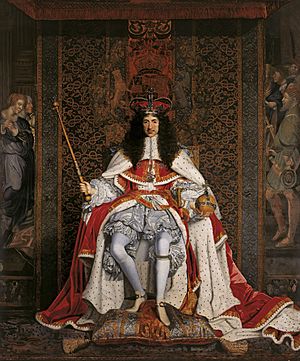
Many people were unhappy without a king. So, in 1660, Charles II was invited to return and become king. This event is called the Restoration. It brought back the monarchy. People learned important lessons from the past. They realized that both the king and Parliament were needed. Problems happened when the king ruled alone, or when Parliament ruled without a king, or when there was a military ruler.
The Puritans, who were very strict, were seen as causing too many problems. So, Protestants who did not follow the Church of England faced restrictions. Catholics and Unitarians faced even stricter rules. People also learned that England needed protection from political violence. The king's answer was a standing army, a professional force controlled by him. This idea was very controversial.
The Restoration aimed to bring back stability. There was little punishment for those who had opposed the king. King Charles was fair and worked hard. He gave important jobs to his old friends and even to some former enemies. His most important advisor was Edward Hyde.
The King and Parliament agreed on a general pardon. This was called the Indemnity and Oblivion Act (1660). It pardoned everyone except for about three dozen people who had signed the order for Charles I's execution. Parliament gave the king a fixed annual payment. They made it illegal to use old, unfair ways of raising money, like fines for knighthood or ship money. Parliament did add a new tax on alcoholic drinks. Foreign trade was also doing well, bringing in more money. Parliament also closed down the harsh special courts Charles I had used.
Religious issues were hard to solve. Charles brought back bishops. But he also tried to work with Presbyterians. Catholics were not allowed to practice their religion freely. Strict rules were put on other Protestant groups in England. They could not hold church services easily. Their members could not hold government jobs. For example, a law in 1665 made it a crime for non-Anglican church leaders to be within 5 miles of their old church.
Parliament was worried about Cromwell's army. It showed that a well-trained army was much better than local militias. Cromwell had used his army to take full control. So, people feared a standing army could threaten their freedom. Cromwell's army was disbanded. All soldiers were paid what they were owed. However, other countries like Spain and France had large armies. So, England needed some defense on land. The king and Parliament agreed on having a strong, larger Royal Navy. But Parliament watched the king's efforts to build a small standing army very closely.
The King's Standing Army
England had never had a permanent army with professional soldiers. It relied on local militias or hired soldiers from Europe. Cromwell changed this with his New Model Army of 50,000 men. This army was much more effective than untrained militias. It allowed Cromwell to control all of England. When the monarchy was restored, Parliament paid off Cromwell's army and disbanded it.
For many years, the idea of a standing army was feared. However, King Charles managed to create four regiments of soldiers. He called them his guards. This became the start of the permanent British Army. By 1685, it had grown to 7,500 soldiers. A rebellion in 1685 allowed James II to increase the army to 20,000 men. By 1694, William III expanded the army to 94,000 soldiers. Parliament became very worried and reduced the army to 7,000 in 1697.
Glorious Revolution: 1688–1689
The overthrow of King James II of England in 1688 is a very important event in British history. It made the Parliament of England more powerful than the King. It also guaranteed legal rights to everyone. Historians see this as a major turning point.
People could no longer tolerate James II. He was too close to the French king. He was Roman Catholic. People also worried about his plans to make the state more powerful without Parliament. What they got instead was the vision of William of Orange. This vision included agreement among leaders, religious tolerance for Protestants, open discussions in Parliament, and strong support for trade. This revolution brought big changes to religion, politics, and foreign policy in England.
William and Mary: 1688–1702
During the joint rule of William and Mary, William made the big decisions when he was in Britain. Mary was in charge when he was away. She also handled church matters. William helped pass important laws that protected people's freedoms. The Toleration Act 1689 guaranteed religious tolerance for Protestant groups who did not follow the Church of England. However, it did not extend this tolerance to Roman Catholics or non-Christians.
In December 1689, a key document in English history, the Bill of Rights, was passed. This Act confirmed many earlier rights. It set limits on the king's power. It said the king could not stop laws passed by Parliament. He could not raise taxes without Parliament's approval. He could not have a standing army in peacetime without Parliament's consent. It also protected the right to speak freely in Parliament. William did not like these limits, but he agreed to the law.
Foreign Policy of William and Mary
The main reason English leaders asked William to invade England in 1688 was to remove King James II. They wanted to stop James from bringing back Catholicism and tolerating Puritans. But William's main reason for accepting was to gain a strong ally. He wanted help in his war against the powerful French King Louis XIV of France. William's goal was to create alliances against France. He wanted to protect the independence of the Netherlands, where he was still in power. He also wanted to keep present-day Belgium out of French hands.
The English leaders strongly disliked France. They generally supported William's goals. William was a lifelong enemy of Louis XIV. Louis XIV saw William as a ruler who had illegally taken the throne from James II. In May 1689, William, now king of England, declared war on France with Parliament's support. England and France were at war almost constantly until 1713.
The combined English and Dutch navies were stronger than France's at sea. But France was stronger on land. William wanted to balance this by allying with the Holy Roman Emperor Leopold I in Austria. William had a clever plan for all of Europe. But Louis XIV always found a way to counter it. The wars were very expensive for both sides but did not have a clear winner. William died just as the next big war, the War of the Spanish Succession (1702–1714), was starting. Queen Anne fought this war, and it ended in a draw.
William III's Impact
Historians generally have a very positive view of King William III. He is seen as someone who saved England from the unfair rule of the Stuarts. He improved the government system. He made it strong enough to last for the next century. The British Army, which became very famous, was largely created by William III. The independence of judges also came from his time.
His government was very expensive. William III's yearly spending was four times higher than James II's. This new level of government was not popular. But the new taxes, which were not too heavy compared to the Dutch, helped England become a great power. They also helped the country's economy grow.
Queen Anne: 1702–1714
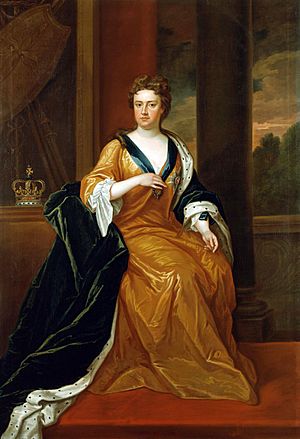
Anne became queen in 1702 at age 37. She took over from William III, whom she disliked. For almost her entire rule, the main issue was the War of the Spanish Succession. Britain played a big part in this European war against Louis XIV of France. Until 1710, Parliament was mostly controlled by a group called the "Whig Junto". Anne did not like them. She relied instead on her friends, Duke of Marlborough and his wife Sarah Churchill, and her chief minister Lord Godolphin.
She made Marlborough the head of the army. His early victories were good for Britain. But the war became long and expensive. The opposing Tories had always been against the war. They won a big election in 1710. Anne then dismissed Marlborough and Godolphin. She turned to Robert Harley. Anne had many pregnancies but only one child survived. He died at age 11. So, her death ended the Stuart period.
Anne was very interested in government matters. She also supported theatre, poetry, and music. She gave money to famous musicians like George Frideric Handel. She started giving out high-quality gold medals for great achievements. These were made by Isaac Newton at the Mint.
Union with Scotland in 1707
Scotland and England had been separate countries with the same ruler since 1603. Queen Anne worked to bring them together in the Acts of Union 1707. Most people in Scotland were against it. But many important leaders supported it. Especially after England offered good financial terms and some payments. The Parliament of Scotland agreed and closed down.
The new Parliament of Great Britain was mostly the old English Parliament. It added 45 Scots elected to the House of Commons. It also chose 16 Scottish nobles for the House of Lords. Scotland was smaller in population and wealth. Its attempt to set up a colony in Panama, the Darien scheme, had been a huge financial disaster. The Acts of Union paid back the Scottish investors who lost money in Darien.
Scotland kept its own Presbyterian church, its own laws, and its own education system. It also kept its separate nobility. Scots now paid English taxes, but at lower rates. They also had a say in the affairs of Great Britain.
The economic benefits took a few generations to be seen. Old distrust continued for many years. The risk of war between the two countries greatly decreased. Ambitious Scots now had great career chances in the growing British colonies overseas. They also found opportunities in England's fast-growing industries and finance. Scotland gained "freedom of trade with England and the colonies." This led to "a great expansion of markets."
Social and Economic Life in Stuart Britain
Population Changes
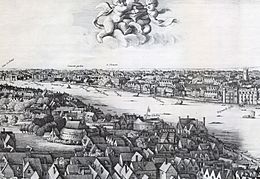
England's population grew steadily from 1600 to about 1660. Then it stayed about the same between 1649 and 1714. In 1603, there were about 4.2 million people. By 1714, it was about 5.3 million. The Greater London area had about 674,000 people by 1714. This was about one in nine of England's population. Most people, about 80-90%, still lived in the countryside.
Witchcraft and Beliefs
People in the Stuart era often believed in magic and witchcraft. The hunting of witches began in England in 1563. Hundreds of people were executed. England had fewer witch trials than other parts of Europe.
The government made witchcraft a serious crime under Queen Elizabeth I of England. King James VI and I made stopping witchcraft a high priority in both Scotland and England. Judges started investigating accused witches more often. This created many detailed local records. Historians believe that witchcraft accusations often happened when communities were breaking down. Older women were often targeted. This was because they were often seen as outsiders.
After 1660, Puritans, who had led many witch hunts, lost their power to investigate. In 1712, Jane Wenham was the last woman found guilty of witchcraft in England. In 1735, Parliament passed the Witchcraft Act 1735. This law made it a crime to accuse someone of witchcraft. The laws against witchcraft were not fully removed until 1951. Scotland had many more witch trials than England. About 3,900 Scots were tried, and two-thirds were executed.
Education and Learning
There was no free schooling for most children. But in towns, small private schools opened for boys from middle-class families. A few also opened for girls. Rich families and nobles hired private teachers. Private schools for upper-class young men also started. Universities existed in Scotland and England. The University of Oxford and the University of Cambridge trained future Anglican ministers.
Historians have looked at old documents to see how many people could sign their names. This helps them guess how many people could read and write. Before 1500, very few people could read. But literacy rates grew steadily. Men were twice as likely to be able to read as women. By 1710, about 25% of women could read, compared to 50% of men. Two main reasons for this growth were the Protestant religion, which encouraged reading the Bible, and the growth of towns. Town jobs often needed people who could read.
Popular Culture and Fun
When the Puritans lost power, strict social rules relaxed. People started enjoying more liberal pleasures. Theatres reopened and became very popular in London. They were supported by the royal family. Historians say that plays from this time, called Restoration comedy, often made fun of rules about gambling, drinking, and love. They aimed to shock people who were more traditional.
The first coffee houses appeared in the mid-1650s. They quickly became popular in cities and towns. By 1708, downtown London had about 600 of them. For a penny, customers could stay as long as they wanted. They could buy coffee, tea, chocolate, and snacks. Middle-class men could read newspapers and magazines. Coffeehouses were quiet places for conversation. They were free from noise and fighting. Working-class people usually went to pubs.
Many business people used coffeehouses to do their work. Some even had regular hours there. Each coffeehouse often had a different type of customer. Some served doctors, others served merchants, writers, or politicians. Coffeehouses were England's first equal meeting places. Men were expected to chat with others at their table, even if they did not know them.
Lloyd's Coffee House opened in 1686. It focused on providing shipping news to merchants, insurers, and shipowners. It later became the famous insurance company Lloyd's of London. By the 1790s, private clubs became more popular. Many penny coffee houses closed down.
High Culture and Science
In science, the Royal Society was formed in 1660. It supported new discoveries. Key figures included Isaac Newton, Robert Boyle, and Robert Hooke. Important scientific breakthroughs were made during this time. These included laws of gravity and motion, Boyle's law, and microscopy.
This period also saw more political news and discussions. Both educated people and ordinary citizens read and talked about current events.
The custom of the Grand Tour started in the 17th century. This was when upper-class Englishmen traveled to Italy. They would visit famous places and learn about art and culture.
Architecture and Building
In the countryside, many architects built grand country houses for nobles and wealthy gentry. Inigo Jones, a famous Stuart-era architect, built the beautiful Banqueting House in London in 1622. Many architects also designed detailed rooms, staircases, and furniture for these houses.
The Great Fire of London in 1666 destroyed many important buildings. This made it necessary to rebuild much of the city. A new law said that buildings had to be made of brick or stone. Streets were made wider. Sir Christopher Wren was in charge of rebuilding the damaged churches. He designed over 50 churches in London. His greatest work was St Paul's Cathedral.
Local Life and Travel
Historians used to think that English villages were very isolated. But new research shows that each village was part of a network of other villages and travel routes. People could move between villages in these networks without feeling like strangers. These networks included market towns and small cities. Roads existed, and some were improved with tolls.
However, the cheapest way to transport goods was by water. Much effort was made to improve rivers by removing obstacles. Later, canals were built, which made transport even cheaper. After 1840, railroads further connected local areas.
World Trade and Economy
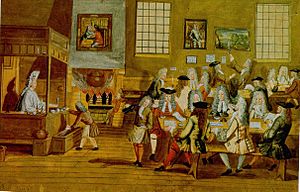
The 18th century was a time of great wealth. Business people expanded their trade around the world. By the 1720s, Britain was one of the richest countries. Daniel Defoe wrote that England was "the most diligent nation in the world." He praised its "vast trade, rich manufactures, mighty wealth."
As an island, Britain focused on building a worldwide trading network. This needed a very strong Royal Navy. The navy had to be powerful enough to protect British ships and prevent invasions. Wool was the main product. England produced enough wool for its own needs. Raw wool and wool cloth made up 75–90% of its exports. Trade was strong with France, the Netherlands, and the Baltic region.
The English colonies in the West Indies provided sugar. Most of this sugar was then sold to other European countries. The 13 American colonies provided land for settlers. They also supplied wood for the navy, food for West Indies slaves, and tobacco. Britain became very strong in trade with India. It also controlled much of the slave, sugar, and trade routes from West Africa and the West Indies. Exports grew from £2.5 million in 1613 to £6.5 million in 1700.
The government supported private businesses. It created many London-based companies to set up trading posts worldwide. Each company was given a monopoly, meaning they were the only ones allowed to trade in a certain area. Examples include the Muscovy Company (1555) for trade with Russia, the East India Company (1599), and the Hudson's Bay Company (1670) in Canada. The Royal African Company (1672) focused on the slave trade.
The Wool Trade
Woolen cloth was England's main export. It was also the biggest employer after farming. In the medieval period, England exported raw wool. But now, it had a wool industry. This industry used England's 11 million sheep. London and other towns bought wool from dealers. They sent it to rural homes where families turned it into cloth. They washed, carded, and spun the wool into thread. Then, they wove it into cloth. Merchants exported these woolens to the Netherlands, Germany, and other places. New skills came from French Protestants who moved to England, which helped the industry grow.
Government actions in the early 17th century caused problems for the wool trade. A new company convinced Parliament to ban the export of unfinished cloth. They argued that finished cloth was more profitable. But this caused huge problems. Large amounts of unsold cloth built up. Prices fell, and unemployment rose. The Dutch also refused to import any finished cloth from England. Exports dropped by a third. The ban was quickly lifted, but the trade losses remained.
Foreign Policy of the Stuart Kings
Stuart England was mostly focused on its own internal problems. King James I (1603–1625) truly wanted peace for his three kingdoms and for all of Europe. He called himself "Rex Pacificus" ("King of peace"). At this time, Europe was very divided. It was on the edge of the huge Thirty Years' War (1618–1648). Protestant states faced attacks from larger Catholic empires.
When James became king, he made peace with Catholic Spain. He planned to marry his son to the Spanish princess Maria Anna. James's daughter, Princess Elizabeth, married a German Protestant prince in 1613. James hoped this marriage would give him influence among Protestants. He wanted to be able to help make peace. But he did not realize that both sides were using him for their own goals.
In the 1620s, Lord Buckingham wanted an alliance with Spain. Buckingham took Charles to Spain in 1623 to meet the princess. But Spain demanded that James stop Britain's anti-Catholic rules. Buckingham and Charles were embarrassed. Buckingham then led the call for war against Spain. Meanwhile, Protestant princes looked to Britain for military help. James's son-in-law became king of Bohemia, which angered Austria. The Thirty Years' War began. James eventually realized his plans had failed. He refused to get involved in the war. He successfully kept Britain out of the devastating European war.
During 1600–1650, the kings tried many times to set up colonies in Guiana in South America. All these attempts failed. The lands were given to the Netherlands in 1667.
Anglo-Dutch Wars
The Anglo-Dutch Wars were three wars between England and the Dutch from 1652 to 1674. They were caused by political disagreements and competition over trade. Religion was not a reason for these wars. Both sides were Protestant. In the First Anglo-Dutch War (1652–1654), Britain had a stronger navy. They also captured many Dutch merchant ships.
In the Second Anglo-Dutch War (1665–1667), the Dutch won naval battles. This war cost London much more than planned. King Charles II asked for peace in 1667 with the Treaty of Breda. This ended the fights over trade control. Meanwhile, France was building up its navy, threatening both the Netherlands and Britain.
In the Third Anglo-Dutch War (1672–1674), Britain allied with France. But the Dutch navy was still stronger. King Charles II ran out of money and political support. The Dutch controlled sea trade routes until 1713. Britain gained the thriving colony of New Netherland, which was renamed New York.
Timeline of the Stuart Period
The Stuart period began in 1603 when Queen Elizabeth I died and King James I became king. There was a break in the middle, but the Stuarts returned to the throne in 1660. The period ended in 1714 (after 111 years) with the death of Queen Anne. Then, King George I, the first king from the House of Hanover, took the throne. The yellow bars show when the Stuarts ruled.
Stuart Monarchs
The House of Stuart had six monarchs who ruled during this time.
-
Charles II
(1660–1685) -
James II
(1685–1688) -
William III
(1689–1702) -
Mary II
(1689–1694) -
Anne
(1702–1714)
Historical Gallery


